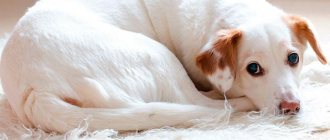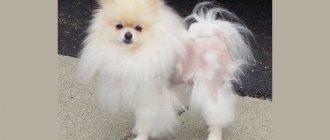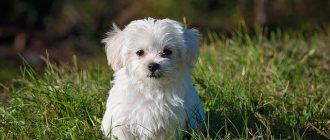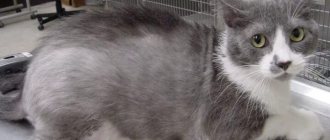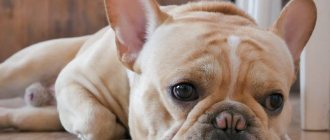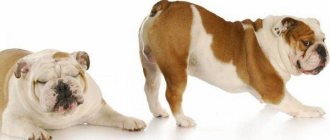Every pet owner needs to know why their dog is losing hair and going bald in places. Owners of animals of different breeds and ages may encounter a similar problem. To eliminate it, they need to immediately contact a veterinarian, provide the pet with full medication treatment and good care.
It must be taken into account that baldness in pets often indicates significant health problems. It may indicate the presence of parasites, changes in hormonal levels, and dermatological diseases. It is important for the owner of the animal to establish the exact cause of this condition of the animal, otherwise he will not be able to cope with hair loss even if he carefully follows the veterinarian’s recommendations.
What is alopecia?
This is hair loss in animals. It may be associated with the natural change of hair coat - molting, but often takes on pathological forms in which the animal experiences baldness of certain parts of the body, the appearance of ulcers and inflammations, as well as tissue pigmentation. Such individuals often have a “fur coat” that comes out in tatters. Such a symptom almost always indicates serious malfunctions in the body’s functioning - hormonal changes, disruption of the functioning of internal organs, or infection of the pet with parasites.
When such a problem arises, the dog owner needs to remain calm. If he notices moderate hair loss in the spring or fall, there is no need to worry. However, if this process begins in winter and is accompanied by a general deterioration in the dog’s condition, the appearance of islands of bare skin on the paws, face, and stomach, you should consult a veterinarian. In most cases, a specialist is able to cope with such a scourge quickly without consequences for the animal’s health.
Why might a dog lose hair?
This phenomenon may occur for the following reasons:
- Due to hormonal imbalances. These include hypothyroidism (with this disease there is dysfunction of the thyroid gland, the skin turns black), hyperestrogenism, Cushing's syndrome, hypoestragonism. Also, a similar phenomenon can be observed in bitches during pregnancy and after childbirth. It does not apply to a number of pathologies.
- Because of stress. They may be associated with a change of place of residence, the death of the previous owner of the animal, or the appearance of other animals in the house. In this case, the pet often loses its hair in clumps to bald spots, there is increased excitability, urinary incontinence, and frequent howling. In this situation, the animal must be given sedatives to relieve symptoms.
- Exposure to allergens on the body. These can be ordinary dust, synthetic materials, and some products included in the animal’s diet. Severe itching, dandruff and hair loss can be caused by the use of low-quality hygiene products: bad shampoos, pet care balms, plastic combs, synthetic leashes, collars, clothing.
- Due to severe infection of the body with parasites: ticks, helminths, fleas. In such cases, the owner will observe not only hair loss, but also severe wounds on the pet’s back, as well as on the pet’s neck, around the tail, and lower abdomen. The animal will constantly scratch these areas due to severe itching. The problem can only be eliminated through antiparasitic treatment of the animal.
- With vitamin deficiency. Accompanied by the appearance of bald spots on the ears, as well as on the face and back of the dog. The condition of the animal with such a disease worsens: there is a decrease in appetite, an exacerbation of chronic diseases (if they have occurred). This problem occurs more often in the off-season, which is why it is often confused with regular molting.
- Due to bacterial infections. In such cases, the dog’s hair falls out profusely and it itches. At the same time, the pet becomes bald in places, the thickness of the hair on healthy areas of the skin does not change.
- For fungal infections of tissues. The most common ringworm in dogs is trichophytosis. Puppies under the age of one year are highly susceptible to such diseases. The diseases are accompanied by the formation of ulcers on the skin, thinning hair, and the appearance of dandruff. Such pathologies are very contagious and are easily transmitted from one animal to another through direct contact, bedding, and toys.
- With acanthosis nigricans. This is a lesion of the sebaceous glands, in which pigmentation of the skin is observed in the groin area, as well as under the armpits. Accompanied by severe itching and the appearance of hard scales on the tissues.
- Due to idiopathic alopecia. This is a specific disease to which representatives of the Greyhound breed are prone. Accompanied by hair loss on the abdomen and thighs. The skin with this pathology remains healthy and does not require specific treatment.
- For adenitis of the sebaceous glands. The disease primarily affects puppies. With this pathology, the owner notices that the animal’s hair is falling out, and in this place there is red skin covered with peels or a greasy coating. The disease requires the use of corticosteroid therapy.
- Due to injuries. These include severe bites, burns, and cuts.
Also, hair loss may not be associated with pathological processes in the body. Twice a year, the hair on the dog’s body is renewed naturally and there are periods of shedding. If your pet's general health does not deteriorate during this time, there is no need to worry about this. Wait for this phase to end naturally and continue caring for your pet.
How to improve the condition of your pet's coat?
There are often cases when a veterinarian’s examination did not reveal pathologies, and the quality of the coat leaves much to be desired. This suggests that the violation can be eliminated by taking into account the following points:
- balanced diet . A natural diet should include 30-50% lean meat (beef, veal, poultry, offal), 20-30% cereals (rice, oatmeal, buckwheat), 20-30% fermented milk products (kefir, cottage cheese), 10% vegetables and fruits (carrots, beets, zucchini). You should give a boiled egg 2-3 times a week, and add greens (dill, parsley) to your food every day. You cannot give milk, pork, potatoes, bread, legumes;
- need for vitamin and mineral supplements . If the dog eats economy-class food or natural food, it is necessary to additionally introduce vitamins A, E, group B, and minerals (calcium, zinc, sulfur). The composition of premium feeds is clearly balanced and (to avoid overdose) allows vitamin supplements only during molting (spring-autumn), pregnancy/lactation. The exception is large animals that need chondroitin/glucosamine;
- unsaturated fatty acids . Omega-3-6 can be introduced into food in the form of sunflower/linseed oil or in capsule form;
- daily oral examination and weekly mechanical teeth cleaning . In advanced cases, tartar removal will be required at a veterinary clinic;
- preventive deworming (at least once every six months) and scheduled treatments for external parasites - if necessary;
- exercise _ Walking, if possible, should be longer; for active animals, outdoor games can be provided;
- combing . Smooth-haired pets require grooming with a brush or rubber mitten once every 2-3 weeks, and during the molting period - 2 times a week. Dogs with medium-length hair need to be brushed at least 2 times a week, and every other day when shedding. For them, it is advisable to buy a comb and a brush with metal/rubber teeth, and also choose a furminator. Long-haired pets need to be lightly scratched every day, and thoroughly combed weekly; during the shedding period, combing is required every day. For long hair, you need a sparse comb, a slicker brush, or a curved comb;
- removing tangles . You should try to untangle them using grooming spray and a comb. A less gentle alternative is a tangle cutter;
- Trimming is an alternative to combing for wire-haired, non-shedding dogs. You can pluck the hairs with a slicker brush with curved teeth or a trimmer;
- bathing _ It is recommended to bathe a healthy animal no more than once every 3 months (at most, monthly), and in the absence of contamination, it is allowed to do this once every six months (spring/autumn). For bathing, use special pet shampoos that do not cause allergies and do not contain harmful surfactants. They do not damage the pH of the skin and the hair structure even with relatively frequent washing. Professional shampoos/conditioners are made taking into account breed characteristics; their regular use will refresh the color;
- use of conditioners and grooming sprays . These products add shine, protect against the negative effects of low/high temperatures, and make combing easier. The conditioner provides active recovery and nutrition after liquid shampoo, and the grooming spray can be used for regular combing, as well as to remove mats.
The listed measures will make your pet’s coat healthy and beautiful, and will also reduce the risk of serious diseases.
How to determine the cause of baldness?
If your pet's hair loss is associated with regular shedding, there is no need to worry about it. It is enough to continue to care for his coat, and this process will end naturally. If your animal has severe alopecia, you should consult a veterinarian. He will conduct the following studies to determine the cause of this condition:
- A general examination of the pet, a survey of the dog’s owner, allowing you to determine in what conditions the dog lives, how long ago his hair loss began, and what processes it is associated with. The doctor will definitely clarify whether there have been contacts with wild animals, changes in hormonal levels, and whether the dog has chronic diseases.
- Blood and urine tests.
- Fur scrapings.
- If damage to internal organs is suspected, the animal may be prescribed an ultrasound or x-ray.
Based on the results of such an examination, the doctor will be able to determine the reason why the dog has a lot of hair and will select the appropriate therapy for it. This will allow you to quickly cope with the presented disease.
Methods for treating hair loss in dogs
The strategy for combating alopecia is selected depending on the factor that provoked this phenomenon:
- If infected with ticks or worms, antiparasitic treatment will be prescribed. In the most severe cases, treatment for alopecia in dogs will involve antibiotics.
- If there is a lack of vitamins and macroelements in the body, the animal will be prescribed specialized complexes and feeds that have a high content of nutrients.
- If baldness occurs due to an allergy, the animal will be prescribed antihistamines, the owner will be advised to change the diet, as well as replace the dog’s accessories and hair care products (often these are the ones that provoke hair loss).
- In case of hormonal imbalances or severe general diseases, the dog will be prescribed long-term combined treatment aimed at eliminating the cause of alopecia. It may take several months.
To eliminate itching, skin inflammation, and dandruff, the dog will be prescribed special local medications that will need to be applied daily to the affected areas of the skin. Products containing melatonin help well in such cases. They are used until symptoms disappear completely.
If you follow all the veterinarian's recommendations, you can cope with alopecia in a few weeks. In the future, you will need to follow preventive recommendations so that the problem does not arise again.
Causes of hair loss in dogs
Partial or complete hair loss in a dog several times a year is a natural shedding process, so such symptoms should not bother the owner much. Shedding does not affect the general well-being of the four-legged friend, and the owner only needs to brush it and monitor the hygiene of the dog’s skin.
But if the process of seasonal molting is still far away, and the pet has widespread or focal alopecia, then the owner must find out the main reasons for the development of such processes.
Hormonal disorders in the body
A dog’s fur can be shed if some kind of hormonal imbalance occurs within the body:
- Cushing's syndrome (hyperadrencorticism) is a disease during which excess cortisol is produced in the body. The main symptoms of the disease with alopecia are weight gain, systematic thirst, and regular urination of the pet.
- Hyperestrogenism. A large amount of estrogen in the dog's body, as a result of which hair begins to fall out in the genital areas.
- Hypoestrogenism. The disease most often occurs in spayed, medium-sized female dogs. Massive hair loss occurs in certain areas, first around the genitals, and then throughout the body.
- Low levels of growth hormone during dog puberty. The disease is of natural origin; Chihuahuas, poodles, boxers, Pomeranians, Dutch Spitz and Airedale Terriers are most susceptible to it.
- Hypothyroidism. Acute deficiency of hormones in the thyroid gland. The wool at this time becomes dry and very brittle. Afterwards it falls out in the chest, neck and back areas.
Other Possible Causes
During the normal functioning of hormonal levels, the causes of hair loss in a dog can be the following:
- Avitaminosis. It especially affects the general condition of the coat due to a lack of vitamin B. A deficiency of zinc levels in the body can lead to rapid baldness.
- Allergic reactions. In dogs they develop due to allergies to food, cosmetics, chemicals, as well as drugs and medications. The shedding process is accompanied by redness and itching.
- Stressful situations. The nervous system of a large number of breeds is designed in such a way that severe inflammation can greatly affect their overall health and cause special reactions in the form of changes in the dog’s appearance and disruptions in the functioning of internal organs. After a fight, a doctor's visit, moving, or other stress, the dog may shed.
- Yeast infections. The process of hair loss most often occurs in dogs with wrinkled skin: Shar Peis, English bulldogs, etc. Hair loss occurs in areas of increased folding.
- Increased scabies. The causative agents of the disease are microscopic scabies mites. The fur begins to fall out in places, first near the eyes, in the corners of the lips, and then over the entire surface of the pet’s body, where the parasite mainly operates.
- Ringworm (trichophytosis). A fungal disease that affects the entire skin of a pet. In this case, round pink spots with fallen hair appear on the body.
- Seborrhea - the skin becomes covered with grayish scales, hair begins to fall out throughout the body.
- Solar dermatitis. Baldness occurs most in the dog's muzzle area. In addition to the process of hair loss, ulcers appear on the surface of the skin.
- Blue Doberman syndrome. A disease that causes severe shedding of hair throughout the pet's body. The dog at this time looks like it has been eaten by moths. At the same time, papules begin to form on the surface of the skin.
- Vitiligo. The skin begins to actively lose all pigmentation. Hair loss occurs rapidly, with the scalp area suffering the most. In most cases, this disease occurs in Rottweilers and Belgian Terriers.
- Adenitis of the sebaceous glands. In most cases, poodles begin to go bald for this reason. Adenitis causes the development of inflammation and death in the hair follicles. Afterwards he moves on to the face and head.
- Demodecosis. A microscopic mite penetrates the hair follicles, which then causes them to die.
- Major dermatitis. Reaction to toxins of parasitic insects. The fur begins to fall out in all places, and scabs begin to form on the skin.
- Pregnant alopecia. Rapid hair loss during the birth of a dog, as well as during pregnancy due to hormonal changes in the entire body. This process can be considered completely normal.
- Alopecia pattern. Complete baldness of small puppies some time after birth. In most cases, there is no need to carry out treatment; the coat will recover on its own, without outside help.
- Acanthosis nigricans. In most cases it occurs in dachshunds. Baldness occurs in the armpits, ears, and also in the folds of the skin. Bald areas of the skin begin to turn black and emit an unpleasant odor.
- Compressed calluses. Hair loss in the area of the hind legs, in most cases in the area of the elbow joints, occurs due to the fact that the dog lies on a hard surface for a long time. This form of baldness is most common in large breed dogs.
- Improper care of your pet's withers, too much zeal when brushing the dog, or bathing it too often can lead to a general weakening of the hair follicles and partial baldness.
- Using the wrong cosmetic products. The dog should be bathed and washed with specialized shampoos. If, in order to save money, you use cheaper human preparations, soap or dish soap, then an active process of hair loss will begin to occur.
Pet grooming
To quickly cope with this disease, it is extremely important to provide the dog with proper and complete care at home. It provides:
- Complete feeding of your pet. During the treatment period, it is recommended to give the dog food with a high content of vitamins, and to completely exclude from the menu all foods that can provoke allergies.
- Providing your pet with adequate rest and protection from stress. In case of infectious diseases, it is recommended to refrain from walking in public places and avoid contact with other animals, especially wild ones. If the dog lives in an enclosure, in a kennel, it is recommended to take him into the house and keep him there until he fully recovers.
- Use of a special protective collar. This remedy is used for severe itching to prevent the animal from scratching the skin. Effective if bald spots appear under the collar, on the face, around the eyes or ears.
- Regular brushing of your pet. Remember that fallen fur greatly irritates the skin and provokes intense shedding.
- The use of local drugs to relieve symptoms of pathology. If your doctor has not prescribed you an ointment, you can use olive oil for this purpose.
- Using special shampoos for bathing dogs. They must be selected by a veterinarian.
It is also extremely important to exclude the possibility of re-infection of the dog with parasites, pathogenic bacteria or fungi. To do this, you should treat the animal’s bedding (or replace it with a new one), its toys, bowls, and combs. The same should be done with the personal belongings of other animals living in the house.
Pregnant and lactating bitches suffering from hair loss should be provided with an enhanced diet. General medications are not used for such individuals, as they can negatively affect the development of the offspring. Sick puppies that have inflammation of the glands should be isolated from the rest of the litter. Otherwise, other babies can quickly catch an infection from them.
This type of care is provided until the dog fully recovers. After the symptoms of the disease disappear, he is again shown to the veterinarian. If he is satisfied with the condition of the animal, you can return to the normal rhythm of the animal’s life, remove restrictions on walking and choose a simpler diet for him.
Video: why does a dog lose hair, and what to do about it?
What causes hair to fall out in clumps?
If you have a lot of hair in your home, you may be wondering what causes your dog's hair to fall out in clumps. Is it because your dog has too much dog hair in his coat? There are a number of reasons why a dog may have too much hair.
Excessive hair loss in a dog is a red flag. If your dog is constantly losing hair in clumps and appears bald, contact your veterinarian for a consultation.
In this article, we will help you analyze and understand the reasons why your dog is losing hair in clumps, so that you can get the answer you are looking for as quickly as possible.
© shutterstock
Reasons that can cause a dog to lose hair in clumps:
- Poor nutrition;
- Stress;
- Skin parasites;
- Skin diseases;
- Allergic reactions;
- Hypothyroidism;
- Scabies.
Hair loss due to disease, stress, feeding and parasites
The first step is to consult your veterinarian. However, if you notice that your dog is losing hair in clumps, then it may be caused by poor diet, stress, parasites or disease.
The quality of the coat, its brightness, strength and pleasant smell are signs that your dog is healthy, eating well and happy. If his fur is brittle and falling out a lot, the first thing you need to do is check how you feed him.
Prevention of alopecia in dogs
To avoid the occurrence of this disease, it is enough to follow simple general recommendations. They provide:
- Regularly examine your pet's skin. It is advisable to carry it out after clipping or washing your pet. When the first signs of afforestation appear, you should immediately consult a doctor.
- Follow the recommendations for caring for the animal's fur. It must be combed out during the molting period, otherwise it will cause skin inflammation and severe itching, which can cause alopecia.
- Providing the dog with a nutritious diet. Your pet's food should contain a large amount of vitamins and minerals. It is especially important to adhere to this rule during the molting period. If you do not know how to feed your dog to prevent hair from coming out, consult your veterinarian on this issue.
- Timely vaccination of the animal and regular deworming.
- Correct selection of accessories for your pet: collar, leash. You need to purchase only high-quality products that do not put pressure on the dog’s neck and do not rub.
The owner also needs to ensure that the pet does not come into contact with other animals or conflict with them, as it can become infected with dermatological diseases from them. If you follow these simple recommendations, you will not encounter alopecia in dogs.
Treatment of alopecia in dogs
Alopecia in dogs
is a pathological hair loss. There is thinning or complete loss of hair in certain parts of the head and body.
There is no universal method of treating the disease.
Only a veterinarian can determine why a dog’s hair began to fall out in a particular case. Therefore, diagnosing yourself is completely useless, and even unsafe.
The doctor will take tests, find out the catalyst disease and explain how to treat the animal.
If the cause is a hormonal disorder, a treatment regimen with special medications will be prescribed.
Metatonin and Trilostane are usually prescribed. Recovery occurs within 6 weeks. If improvement is not noticeable, then the drugs are reviewed.
Parasitic diseases
If your pet's fur begins to fall out due to the presence of parasites, then drops will be prescribed to kill them.
Flea bites cause severe itching. The dog begins to scratch the wounds, and inflammation develops. Treatment requires only specific medications that the doctor will select. Hairworms and demodex mites also cause baldness. With a fungal infection, the hair falls out in clumps. Bare areas become inflamed and become covered with crusts. If the damage is significant, the hair may not recover even after treatment. Immunostimulating agents are intended to stabilize the immune system.
During the treatment period, feed should contain vitamin complexes to stimulate the growth of the undercoat.
Allergy
Hair loss occurs as a result of allergic reactions to household chemicals, medications, and parasite repellents. Flea bites also cause allergies. A characteristic difference between allergies is baldness on the back and sacrum.
A pet owner can independently prevent alopecia by monitoring the dog’s immune system and providing it with a balanced diet.
